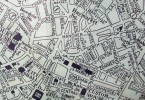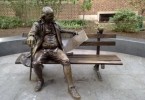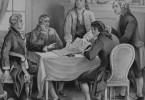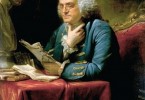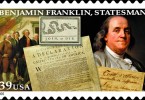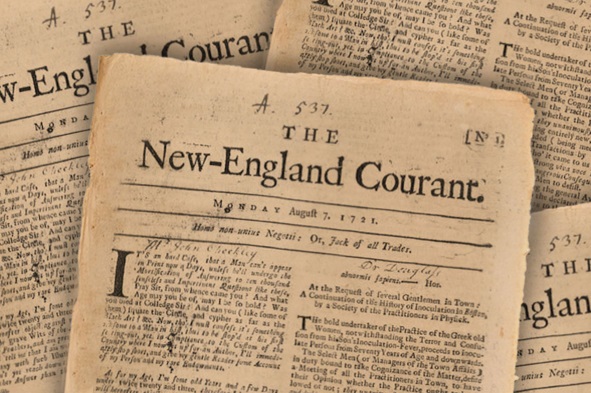
The New England Courant was founded in 1721 by James Franklin. It ceased publication in 1726.
The New England Courant
Benjamin Franklin was introduced to the art of printing and journalism by his brother James. He started working with him as an apprentice when he was 12, Benjamin signed an indenture for his apprenticeship which bounded him until he turned 21 and only then he could earn wages. In 1721 James Franklin founded the New England Courant; the second newspaper in America, the first one was the Boston Newsletter.
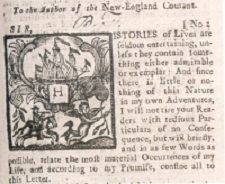
Silence Dogood was the pen name Franklin used to publish articles in the New England Courant
Young Benjamin was in charge of setting the letters for the printer and sell newspapers door to door but what he really wanted to do was to write and knew his brother would object. One day it occurred to him to write an anonymous article under the pseudonym of Silence Dogood. James was impressed and published the letters. From April to October 1722 he submitted 14 Dogood letters which were well received and published by the Courant. Dogood was a fictitious character, the widow of a country minister, “an Enemy to Vice, and a Friend to Virtue”. She abhorred arbitrary government and unlimited power.
The New England Courant was a liberal newspaper publishing humorous articles and cartoons against the colonial government. One of the pieces published in June 1722 offended the Assembly and James was jailed for two weeks for contempt as he did not disclose the author. While James was in jail Benjamin ran the business and the newspaper was published under his name and continued to until the Courant ceased to operate in 1726.
Benjamin decided to ran away from his brother and taking advantage of a clause in his indenture he was able to free himself from the contract that tied him to James.
Networking
Franklin spent 18 months in England during a failed attempt to purchase printing equipment to start his own business. William Keith, the colonial governor of Pennsylvania had promised Franklin letters of credit to purchase equipment but those letters never materialized.
While in England he acquired skills in printing shops that no one else had in America. Back in Philadelphia he continued his employment with Thomas Denham, who had loaned him money to return to America.
Franklin briefly returned to work for Samuel Keimer who was in a great deal of debt. Keimer was given a project that involved printing money in New Jersey. It involved skills in cutting and types that only Franklin could supply as no one had the skills. The copper press plate was the first one ever used in the country. For three months while at this job Franklin met friends in positions of power such as Judge Allen, Samuel Bustill, the Secretary of the province; Isaac Pearson, Joseph Cooper, members of the Assembly and Isaac Decow, the surveyor general. These people would eventually shape the events of his life and contribute to his wealth.
Franklin’s Printing House
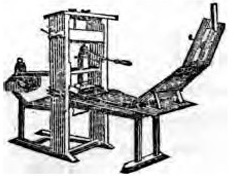
Franklin’s printing press.
In 1728, when Franklin was 22 years old, he entered a partnership with Hugh Meredith, a co-worker at Keimer’s Printing Shop. With a loan from Meredith’s father who had a high regard for Franklin they were able to rent a house and import printing equipment from England. His printing skills were set against the loan and profit would be shared equally. Their first customer was a farmer referred by a friend.
Franklin was industrious, disciplined and hard working. When required he stayed until late night while his partner Meredith had taken to drinking. Meredith’s father had paid only half of what they owed for the equipment and creditors were demanding payment. Two friends offered their help but only if he let Meredith go. Fortunately, Meredith realized that he was better off returning to what he really liked doing, farming. Franklin bought his share of the business and became the sole owner.
Read more about Franklin’s Printing House
The Pennsylvania Gazette
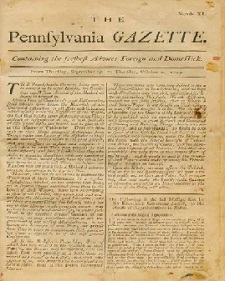
The Pennsylvania Gazette was founded by Samuel Keimer in 1728
In 1729 Franklin purchased the Pennsylvania Gazette from his former employer, Samuel Keimer, who was greatly indebted. He improved its appearance with better types, articles and news and the number of subscribers grew exponentially.
The Pennsylvania Gazette was published twice a week and contained news and reports on public events. What made this paper different from others was the publication of essays and letters from readers, much of which was written by Franklin himself under pseudonyms. He resisted making the Gazette partisan.
In 1736 Benjamin Franklin was elected clerk of the Pennsylvania Assembly which was an advantage to his business as he was able to secure profitable printing jobs such as votes, laws and paper money, as well as more advertisers for his newspaper.
The following year Franklin was appointed Postmaster of Philadelphia which allowed him to increase his newspaper’s circulation allowing riders (mailmen) to deliver the Pennsylvania Gazette to more customers.
Read more about The Pennsylvania Gazette
Official Printer of Pennsylvania and New Jersey
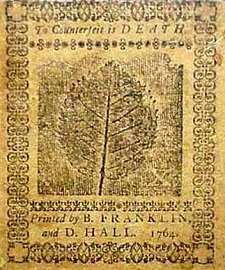
Franklin and his partner David Hall were the official printers of currency in Pennsylvania and New Jersey.
The economy of Pennsylvania was improving partly because of increased circulation of paper currency. Franklin wrote “The Nature and Necessity of a Paper Currency” supporting and giving evidence of the positive effect in the economy while warning on excessive printing. His opinion was that silver and gold are not the true measure of a nation’s wealth but the labor its inhabitants are able to purchase.
The essay was very popular and helped persuade the legislature to increase circulation of paper money. His friends at the legislature considered that he had been of some service and rewarded him with a contract to print paper currency, a very profitable job. In 1730, when Franklin was 24 years old, he became the official printer of Pennsylvania and in 1736 he was chosen as the official printer of New Jersey.
Read more about Official Printer of Pennsylvania and New Jersey
Poor Richard’s Almanac
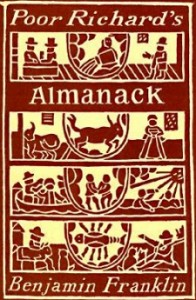
Poor RIchard’s Almanak started publication in 1732. The first almanac in Pennsylvania was published by Samuel Atkins in 1686.
Franklin’s greatest success as a businessman came from his almanac, Poor Richard. In 1732 Franklin published his first almanack under the name of Richard Saunders and continued for the next 25 years. It contained the calendar, weather, sayings, poems, demographics, aphorisms, and proverbs about industry and frugality. Franklin considered it a vehicle of instruction for common people who could not afford books, a literature for the masses.
The almanack was a best seller in the American colonies printing up to 10,000 copies a year. Its success brought wealth to Benjamin Franklin, the printer.
Read more about Poor Richard’s Almanac
Franchise
By the early 1730s his business was thriving. It was Franklin’s idea to franchise his business by promoting workers and establishing them with a printing house in other colonies for half the profits in a six year term. At the end of the 6-year term they were allowed to purchase the equipment from him and work for themselves.
Retirement from printing
In 1748 Franklin took a partner, David Hall, who took care of the daily printing business leaving him more time for public projects.
With the fortune he had built he was able to live comfortably and engage himself in public projects and electrical experiments.
His partnership with David Hall expired in 1766. Franklin sold his entire printing business to him.

